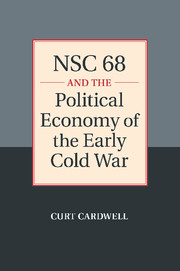Book contents
- Frontmatter
- Contents
- Acknowledgments
- Abbreviations
- Introduction
- 1 NSC 68 and the Problem of Origins
- 2 Multilateralism, the Soviet Threat, and the Origins of the Cold War
- 3 Multilateralism, the Dollar Gap, and the Origins of the Cold War
- 4 The Dollar Gap and Its Discontents
- 5 The British Sterling-Dollar Crisis of 1949–1950
- 6 The Origins and Development of NSC 68
- 7 The Political Economy of Rearmament
- Conclusion
- Select Bibliography
- Index
- References
3 - Multilateralism, the Dollar Gap, and the Origins of the Cold War
Published online by Cambridge University Press: 05 July 2011
- Frontmatter
- Contents
- Acknowledgments
- Abbreviations
- Introduction
- 1 NSC 68 and the Problem of Origins
- 2 Multilateralism, the Soviet Threat, and the Origins of the Cold War
- 3 Multilateralism, the Dollar Gap, and the Origins of the Cold War
- 4 The Dollar Gap and Its Discontents
- 5 The British Sterling-Dollar Crisis of 1949–1950
- 6 The Origins and Development of NSC 68
- 7 The Political Economy of Rearmament
- Conclusion
- Select Bibliography
- Index
- References
Summary
Western Europe's exports to North America have nearly reached, in physical volume, the 1938 level. But the 1938 level, or for that matter any pre-war level, is not a relevant target.… Europe can no longer finance a large surplus of dollar imports; the dollar trade deficit must be drastically narrowed. If for the near future this must be done primarily by a reduction in Europe's dollar imports, this is obviously no real or permanent solution. Somehow, both Europe's dollar earnings from exports, and the availability of non-dollar supplies of food and raw materials, must be enormously increased, as compared with both present and pre-war volumes, if there is again to be a strong and prosperous Western Europe and a functioning world economy.
Harland B. Cleveland, 1949For U.S. foreign policy officials committed to creating a multilateral economy in the aftermath of WWII, the Soviet Union presented a formidable obstacle. As we have seen, however, the Soviet Union was not a hostile power against which the United States simply had no choice but to respond defensively. In fact, given the evidence presented in Chapter 2, it is difficult to contend that the Cold War can be laid at the feet of the Soviets. That said, if there were no other explanation that might account for the origins of the Cold War it would have to be conceded that, even given the relatively benign nature of the Soviet threat in the immediate postwar period, it nonetheless sits at the heart of the Cold War.
- Type
- Chapter
- Information
- NSC 68 and the Political Economy of the Early Cold War , pp. 58 - 91Publisher: Cambridge University PressPrint publication year: 2011

